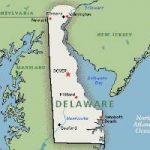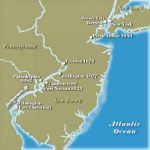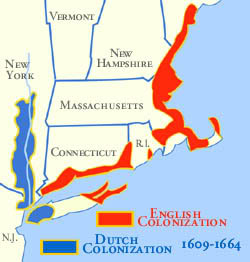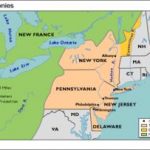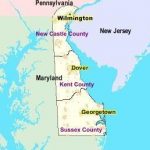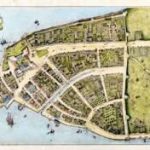The Year: 1638
New Sweden was a small Swedish settlement along the Delaware River on the Mid-Atlantic coast of North America. It was centered at Fort Christina, now in Wilmington, Delaware, and included parts of Delaware, New Jersey, and Pennsylvania. The settlement was founded March 29, 1638, and was incorporated into Dutch New Netherland on September 15, 1655. Along with Swedes, a large number of the settlers were Dutch.
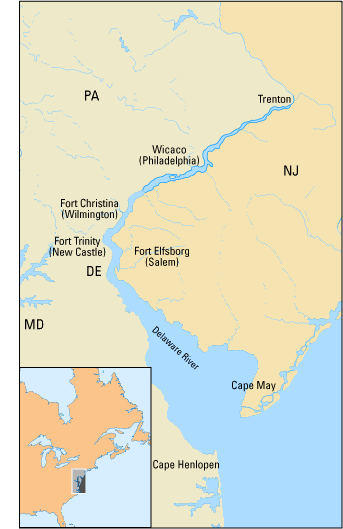
By the middle of the 17th century, Sweden was one of the great powers in Europe. Sweden then included Finland and Estonia and parts of modern Russia, Poland, Germany and Latvia. Inspired by the other European powers, the Swedes wanted to expand their territory into the New World. America was seen as the standard-bearer of enlightenment and freedom, and became the ideal of liberal Swedes.
Peter Minuit
In 1637, Swedish, Dutch and German stockholders formed the New Sweden Company to trade for furs and tobacco in North America. Under the command of Peter Minuit, the company’s first expedition sailed from the port of Gothenburg in late in 1637 in two ships. Minuit had been the governor of the Dutch colony, New Netherland, from 1626 to 1631.
In late March 1638, the members of the expedition, aboard the ships Fogel Grip and Kalmar Nyckel, sailed into Delaware Bay and anchored at a rocky point that is known today as Swedes’ Landing.
Peter Minuit was to become the first governor of the newly established colony of New Sweden. Having been the Director of the Dutch West India Company, he knew the status of the lands on either side of the Delaware River at that time. He knew that the Dutch had established deeds for the lands east of the river (New Jersey), but not for the lands to the west (Maryland, Delaware, and Pennsylvania).
Minuit gathered the chiefs of the local Native American Tribes, held a powwow in his cabin on the Kalmar Nyckel, and persuaded them to sign some deeds he had prepared. Minuit purchased land on the west bank from the Schuylkill River to Bombay Hook.
The segment of land he purchased from the Chiefs included today’s Philadelphia, southeastern Pennsylvania, Delaware, and Maryland. Dutch Director Kieft objected to the landing of the Swedes, but Minuit ignored him because he knew that the Dutch were not a military threat at that time.
The Swedes built a fort on the present site of the city of Wilmington, which they named Fort Christina, in honor of Sweden’s twelve-year-old queen. It was the first permanent European settlement in the Delaware Valley.
Minuit then returned to Stockholm for a second load of settlers, leaving 24 men to man the fort and trade with the Native Americans. He made a side trip to the Caribbean to pick up a shipment of tobacco for resale in Europe in order to make the voyage profitable. Minuit died while on this voyage during a hurricane at St. Christopher in the Caribbean.
Swedish Expansion
In 1640, the Kalmar Nyckel, on its second voyage, brought the first families to New Sweden, and the Swedes purchased more land—from Schuylkill to the Falls of the Delaware.
During the next seventeen years, twelve more Swedish expeditions left the homeland for New Sweden. A total of eleven vessels and some 600 Swedes and Finns reached their destination. The colony eventually consisted of farms and small settlements along both banks of the Delaware River into modern Delaware, New Jersey, Pennsylvania and Maryland.
New Sweden rose to its greatest heights during the governorship of Johan Printz (1643-1653). He extended settlement northward from Fort Christina along both sides of the Delaware River and improved the colony’s military and commercial prospects by building Fort Elfsborg on the New Jersey side, in order to seal the Delaware River against English and Dutch ships.
Despite these aggressive steps, the Swedish and Finnish colonists lived peacefully with their Dutch and Native American neighbors.
But Governor Printz’s autocratic rule left many settlers dissatisfied, and a petition for reform led to his return to Sweden.
In 1654, Printz was succeeded by the colony’s last governor, Johan Rising, at a time when the Dutch capitol of New Amsterdam was ruled by the hot-tempered Peter Stuyvesant.
Soon after arriving in New Sweden, Rising attempted to remove the Dutch from the colony by seizing Fort Casimir (present-day New Castle, Delaware), below Fort Christina on the western shore of the river. The fort was taken without a fight because its garrison had no gunpowder, and the fort was renamed Fort Trinity.
Dutch Rule
In 1655, food shortages plagued the colony. Some settlers moved to the Sassafras River in Maryland. In September, Dutch Governor Stuyvesant, with seven armed ships and 317 soldiers, invaded New Sweden. Badly outnumbered, the Swedes surrendered the colony without a fight. Governor Rising and 36 others return to Sweden.
Most of the Swedes and Finns decide to stay in America, pledging allegiance to the Dutch. Governor Stuyvesant permitted the colonists to choose their own government, practice their religion, organize their own militia, retain their land holdings, and continue trading with the native people.
English Rule
The Dutch ceded their North American colonies to England in 1664, after relations between the two countries had degenerated into commercial and military rivalry. England’s King Charles II granted his brother James, Duke of York, land in New Netherlands, then sent a fleet to secure the “gift.”
Despite the urging of Peter Stuyvesant, the Dutch civilians in New Netherlands wouldn’t fight. When they surrendered to the English on August 29, 1664, New Netherland became New York. From New York, the English administered the Delaware Valley and instituted two major systems for the courts and land ownership. Some Swedes received patents for their land.
This status lasted until the area was included in William Penn’s charter for Pennsylvania, in 1682.
SOURCES
Wikipedia: New Sweden
A Brief History of New Sweden
Colonial America: New Sweden

